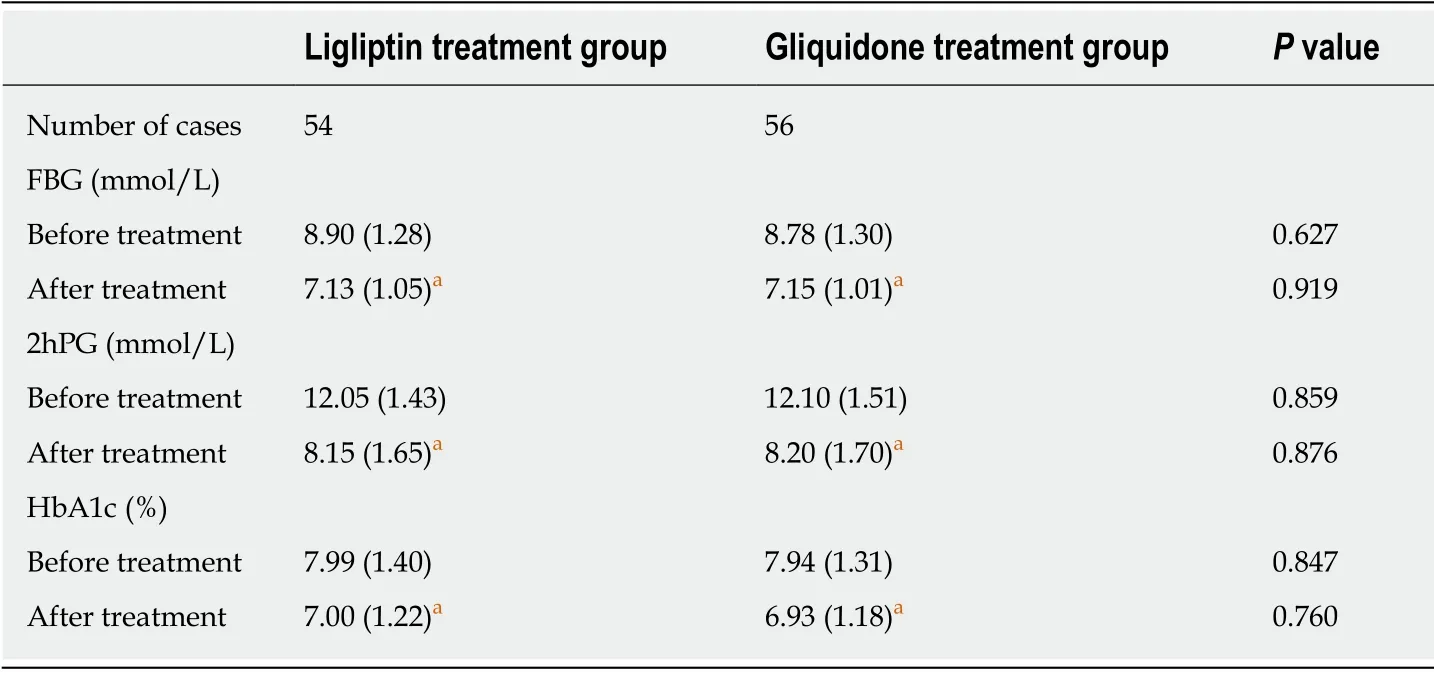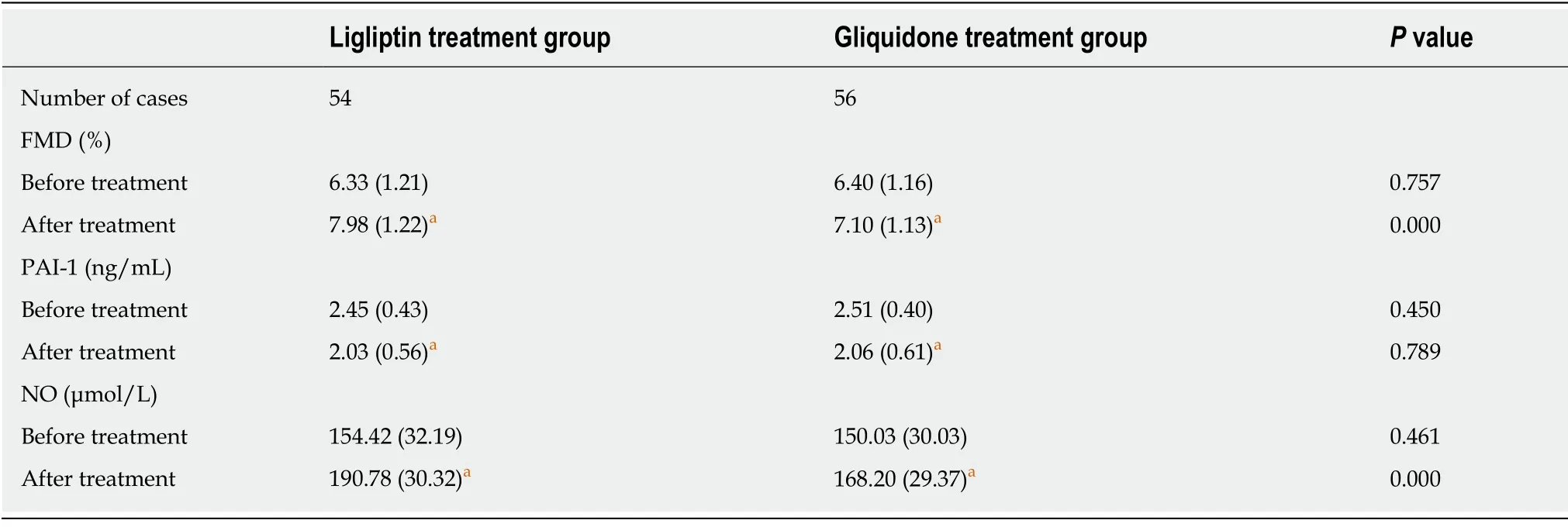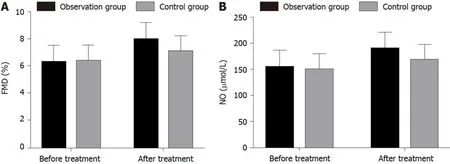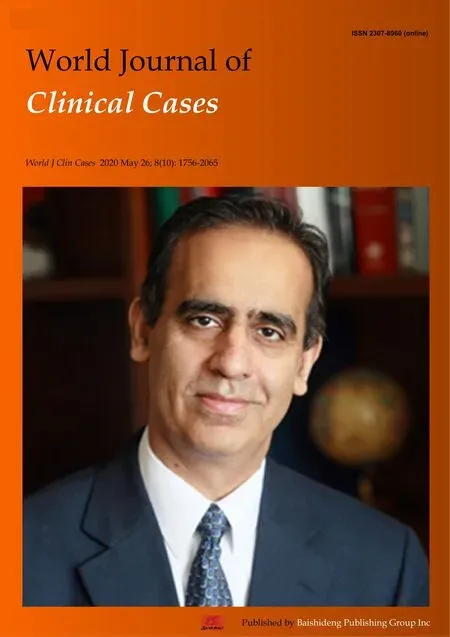Ligliptin for treatment of type 2 diabetes mellitus with early renal injury:Efficacy and impact on endogenous hydrogen sulfide and endothelial function
Jian Zhang,Yong-Li Du,Hui Zhang,Hong Sui,Wei-Kai Hou
Jian Zhang,Wei-Kai Hou, Department of Endocrinology,Qilu Hospital of Shandong University,Jinan 250012,Shandong Province,China
Jian Zhang,Department of Endocrinology,Central Hospital of Tai'an City,Tai'an 271000,Shandong Province,China
Yong-Li Du, Department of Pharmacy,Tai'an Central Hospital,Tai'an 271000,Shandong Province,China
Hui Zhang,Department of Rheumatology,Tai'an Central Hospital,Tai'an 271000,Shandong Province,China
Hong Sui,Department of Geriatrics,Tai'an Central Hospital,Tai'an 271000,Shandong Province,China
Abstract
Key words:Ligliptin;Type 2 diabetes;Early renal injury;Serum endogenous hydrogen sulfide;Endothelial cell granules;Endothelial function
INTRODUCTION
Diabetes is a clinically common chronic disease,and its incidence has been increasing in recent years.At present,nearly 100 million people in China have suffered from this disease.As the disease progresses,type 2 diabetes(T2DM)can cause kidney function damage and abnormal glucose and lipid metabolism in the body,which will cause changes in glomerular filtration in the kidney,affect renal tissue metabolism,and result in excessive formation of glycosylation products and severe renal failure[1].
At present,diabetes is believed to accelerate the process of atherosclerosis in patients,and abnormal endothelial function is an important factor leading to diabetic kidney damage.The dipeptidyl peptidase 4 inhibitor ligliptin belongs to intestinal insulinotropic drugs,which can effectively reduce blood sugar.It has certain effects on the cardiovascular system and does not increase adverse reactions.The specific mechanism may involve improving vascular endothelial function,but clinical reports are relatively rare[2].
In order to further confirm the effect and specific mechanism of ligliptin application in patients with T2DM with kidney injury,this study compared the effects of ligliptin and gliquidone in this population.
MATERIALS AND METHODS
General information
A total of 110 patients with T2DM and early kidney injury treated at our hospital from January 2018 to April 2019 were selected.The inclusion criteria were as follows:T2DM met the criteria established by the World Health Organization;the urinary albumin excretion rate(UAER)was 20-200 μg/min;no urinary tract infection,acute and chronic nephritis,or other kidney diseases;informed consent was obtained from the patients and their families.The exclusion criteria were:Concomitance with other diseases such as malignant tumors,immune system diseases,hematological diseases,and cardiac insufficiency;there was a history of taking hormonal drugs,immunomodulators,and nephrotoxic drugs within 1 mo before the study.
According to the treatment regimen,they were divided into a ligliptin group(n=54)and a gliquidone group(n=56).There was no significant difference in general information between the two groups of patients,as shown in Table 1.
Treatments
Ligliptin 5 mg(Boehringer Ingelheim;drug approval number:National Drug Standard J20171087;drug batch number:20180214)was administered before breakfast once a day,and the effects were observed after continuous treatment for 4 mo;gliquidone 30 mg(Beijing Wanhui Shuanghe Pharmaceutical Co.,Ltd.;drug approval number:National Drug Standard H10940258;drug batch number:20180116)was administered before the three meals daily,and the effects were observed after continuous treatment for 4 mo.
Detection methods
Fasting venous blood(5 mL)was collected from patients before and 4 mo after treatment,and serum was separated at 2000 rpm and frozen at -80 °C for examination.Fasting blood glucose(FBG),2 h blood glucose(2hPG),UAER,and blood urea nitrogen(BUN)were determined by continuous monitoring method using the H-800 biochemical analyzer from Japan Elekko Corporation.Cystatin C(CysC)was measured by particle-enhanced immunoturbidimetry.Glycated hemoglobin(HbA1c)was measured by ion-exchange high-pressure liquid chromatography.Endothelindependent diastolic function(FMD),plasminogen activator inhibitor-1(PAI-1),and nitric oxide(NO)were measured by enzyme-linked immunosorbent assay.Serum endogenous H2S was determined with a spectrophotometer.For determination of endothelial cell microparticles,they were mixed with 50 μL of platelet-depleted plasma and 4 μL of mouse anti-human CD31-phycoerythrin fluorescein and mouse anti-human CD42b-fluorescein isothiocyanate.The buffer was diluted and analyzed by flow cytometry,and standard microspheres with a diameter of 1.0 μm were gated at the forward angle.The diameter of the collected particles was<1.0 μm.Mouse antihuman CD31-phycoerythrin fluorescein and mouse anti-human CD42b -An example of fluorescein isothiocyanate ratio<1.0 μm in diameter is defined as endothelial cell microparticles.
Statistical analysis
Data analyses were performed using SPSS22.0 software.FPG,HbA1c,and other data are expressed as the mean ± SD.Differences between groups were compared using independent samplet-tests.Gender and other data were compared usingχ2test.P<0.05 was considered statistically different.
RESULTS
Comparison of blood glucose levels before and after treatment between the two groups
FBG,2hPG,and HbA1c after treatment were significantly lower than those before treatment in both groups(P=0.000 for all).There was no significant difference in FBG,2hPG,or HbA1c between the two groups(P=0.919,0.876,and 0.760,respectively;Table 2).
Comparison of renal function indexes before and after treatment in the two groups
UAER,BUN,and CysC after treatment were significantly lower than those before treatment in both groups(P=0.000 for all).UAER,BUN,and CysC after treatment were significantly lower in the ligliptin treatment group than in the gliquidone treatment group(P=0.000 for all;Table 3 and Figure 1).

Table 1 Comparison of general information between the two groups
Comparison of serum endogenous H2S and endothelial cell microparticles before and after treatment in the two groups
After treatment,the endogenous H2S and endothelial cell microparticles in the serum were decreased in the ligliptin treatment group and the gliquidone treatment group compared with those before treatment(P=0.000 for all).After treatment,serum endogenous H2S and endothelial cell microparticles were significantly lower in the ligliptin treatment group than in the gliquidone treatment group(P=0.000 for both;Table 4 and Figure 2).
水利风景区以水体或水利工程(如水库、灌区、河道、堤防、泵站、排灌站、水利枢纽及河湖治理等)为依托,水利设施的主导功能是社会功能及生态功能,其安全生产和运转是一切工作开展的前提,其他一切活动必须严格保证在不影响水利设施工作的前提下进行。相对而言,旅游的开展要受到一系列制约因素的限制,如对水体的严格保护、相关生活娱乐设施的选址等。
Comparison of vascular endothelial function before and after treatment in the two groups
The FMD,PAI-1,and NO of the ligliptin group and the gliquidone group were improved after treatment(P=0.000 for all).FMD and NO were significantly higher in the ligliptin treatment group than in the gliquidone treatment group(P=0.000 for both;Table 5 and Figure 3).
DISCUSSION
T2DM is a common endocrine metabolic disease.The improvement of Chinese people's living standards and changes in lifestyles have caused the rising incidence of diabetes in China,which has become a public health problem that seriously endangers public health.Due to a variety of chronic complications of diabetes,some patients will have microvascular and macrovascular pathological changes,which seriously affect the quality of life and physical and mental health of patients[3].
Kidney injury is one of the most common complications of diabetes.Nearly 2/5 of end-stage renal diseases are caused by diabetes.Patients with kidney injury have early mesangial hyperplasia,thickened glomerular basement membrane,and severe changes in glomerulosclerosis.The pathological analysis found that the glomerulus volume of patients with diabetic nephropathy(DN)increased,and mesangial cells showed proliferative changes,accompanied by obvious inflammatory cell infiltration[4,5].At present,it is clinically believed that there are many mechanisms by which diabetes causes kidney damage.Due to non-enzymatic glycosylation,the formation of macromolecular glycosylation end products is too much,and protein kinase activation leads to increased polyol pathway activity and oxidative stress that can cause kidney damage[6];on the other hand,hyperglycemia induces the proximal tubules of the kidney to secrete inflammatory factors and a variety of cytokines,leading to the process of renal interstitial fibrosis,which promotes fibrosis and an increase in the number of mediators of epithelial mesenchymal transdifferentiation[7].At the same time,the hyperglycemic state of the cells will cause the activation of aldose reductase.Thus,glucose is converted into sorbitol,fructose is formed in the human body and unable to pass through the biofilm,and the osmotic pressure in the cell increases.As a result,edema of cells occurs,sodium-potassium-ATP enzyme activity in the body decreases,and endothelial cells are damaged by hypoxia,which leads to the continuous progression of DN[8].In addition,disorders of human fat metabolism can also cause glomerulosclerosis.Changes in the structure of adiposeresistant acids,increased secretion of vasoconstriction active substances,increased glomerular capillary pressure,and changes in glomerular hemodynamics can accelerate the continuous progression of DN[9,10].At present,clinical treatment of DN is not radical.The method is mainly targeted treatment to delay the exacerbation of the disease,so for DN,on the one hand,it is necessary to control the patient's blood glucose and blood pressure while cooperating with sports,diet,and other conventional treatments to reduce the accumulation process of glomerular extracellular matrix and regulate the glomerular blood.Hydrodynamic changes reduce the damage of cells by inflammatory factors with the goal of reducing proteinuria formation in DN[11].

Table 2 Comparison of blood glucose levels before and after treatment between the two groups
Gliquidone is a second-generation oral sulfonylurea hypoglycemic agent that can bind to specific receptors on the islet β-cell membrane and induce the production of appropriate amounts of insulin to reduce blood glucose concentration,but the advantage in terms of renal protection is not obvious.Gliptin is used in the treatment of hypoglycemic patients with T2DM and kidney injury.The drug is a dipeptidyl peptidase-IV inhibitor.Dipeptidyl peptidase-IV is a peptidase with special uses in the human body,which can quickly reduce the concentration of human glucagon-like peptide-1.Glucagon-like peptide-1 levels are extremely low when the body does not eat under normal conditions.It will rise rapidly within a few minutes after eating,accelerate human insulin secretion,and reduce blood sugar after meals.However,the blood glucose level is relatively low and its hypoglycemic effect is reduced,thus reducing the occurrence of hypoglycemic events[12].This study showed that FBG,2hPG,and HbA1c were lower in both the ligliptin group and the gliquidone group after treatment than those before treatment.However,there was no statistically significant difference between the two groups,indicating that the effect of ligliptin in improving blood glucose reduction in patients with diabetes and kidney injury is comparable to that of gliquidone and that it is relatively safe.This study also found that UAER,BUN,and CysC were lower in both the ligliptin-treated group and the gliquidone-treated group compared with those before treatment;the UAER of the ligliptin-treated group was significantly lower than that of the gliquidone-treated group,indicating that ligliptin is superior to gliquidone in improving renal function in patients with diabetes and kidney injury.CysC is a non-glycosylated basic protein,and it is generally catabolized by epithelial cells in the glomerular capillaries.The concentration in the body is maintained at a certain level,and its concentration change indirectly reflects the degree of renal function impairment[13,14].This is mainly because ligliptin can inhibit the degradation of glucagon-like peptide-1 and inhibit intercellular adhesion molecule-1,thus reducing macrophage filtration,oxidative stress,and the incidence of DN[15].Animal experiments have found that the administration of ligliptin in a mouse model can reduce proteinuria and kidney histological changes,and at the same time,it can elevate levels of stromal cell-derived factor-1α in the body are repaired by carrier cells to the site of tissue damage and exert renal protection[16].
Endothelial dysfunction is an important cause of kidney injury.Both NO and PAI-1 can be used to evaluate changes in endothelial function.The former is a protective and powerful vasodilating substance and an important indicator of endothelial progenitor cell function,while the latter is tissue in plasma,an important biological inhibitor of type plasminogen activator.Elevated concentrations of PAI-1 are closely related to hyperglycemia-related endothelial dysfunction and accelerated atherosclerosis[17].H2S are formed in many mammals and have Physiological regulation that is generally formed by cysteine under the catalysis of cystathionine-bsynthetase and cystathionine-1-lyase,which is produced by H2S in pancreatic tissue and islet β cells And its synthetase expression[18].In this study,serum endogenous H2S and endothelial cell microparticles in the ligliptin-treated and gliquidone-treated groups were lower than those before treatment.In addition,serum endogenous H2S and endothelial cell microparticles in the ligliptin treatment group were significantly lower than those in the gliquidone treatment group.The FMD,PAI-1,and NO in both groups were improved after treatment;the FMD and NO were significantly higher in the ligliptin treatment group after treatment,suggesting that ligliptin is superior to gliquidone in improving endothelial cell damage in patients with diabetes mellitus and kidney injury.This is mainly because ligliptin can increase the concentration of glucagon-like peptide-1,by increasing adiponectin and reducing the concentration of nitric oxide synthase inhibitor L-dimethylarginine,the level of nitric oxide can be increased,and at the same time,it can be related to the resistance to peroxynitrite and autophagy[19,20].
This study confirmed that ligliptin has a certain effect in reducing blood glucose in patients with T2DM,which is similar to previous studies,and found that it is superior to gliquidone in improving renal damage and regulating vascular endothelial function in patients.H2S,an important indicator of endothelial cell function,has rarely been observed in clinical studies in the past.Ligliptin can delay the progression of T2DM with kidney injury to a certain extent,providing clinical benefits.A new treatment idea was given in this study,but the follow-up time was short,the number of patients enrolled was small,and there may be measurement errors that have affected the accuracy of the results.Therefore,it is necessary to expand the sample size and conduct long-term follow-up studies to confirm our findings.
To sum up,ligliptin has a better effect on T2DM with early renal injury,and it can significantly improve patients' renal function and vascular endothelial function,and reduce serum endogenous H2S and endothelial cell particle levels.

Figure 1 Histogram of urinary albumin excretion rate before and after treatment in the two groups.UAER:Urinary albumin excretion rate.

Table 3 Comparison of renal function indexes between the two groups before and after treatment

Table 4 Comparison of serum endogenous hydrogen sulfide and endothelial cell particles before and after treatment between the two groups

Table 5 Comparison of vascular endothelial function between the two groups before and after treatment

Figure 2 Histograms of endogenous hydrogen sulfide and endothelial cell microparticles in serum before and after treatment in the two groups.A:Hydrogen sulfide;B:Endothelial cell granules.H2S:Hydrogen sulfide.

Figure 3 Histograms of endothelin-dependent diastolic function and nitric oxide before and after treatment in the two groups.A:Endothelin-dependent diastolic function;B:Nitric oxide.FMD:Endothelin-dependent diastolic function;NO:Nitric oxide.
ARTICLE HIGHLIGHTS
Research background
Diabetes is believed to accelerate the process of atherosclerosis in patients,and abnormal endothelial function is an important factor leading to diabetic kidney damage.
Research motivation
The dipeptidyl peptidase 4 inhibitor ligliptin can effectively reduce blood sugar.It has certain effects on the cardiovascular system and does not increase adverse reactions.
Research objectives
This study aimed to investigate the efficacy of ligliptin in the treatment of type 2 diabetes mellitus(T2DM)with early renal injury and its effect on serum endogenous hydrogen sulfide,endothelial cell particles,and endothelial function.
Research methods
Totally 110 patients with T2DM and early kidney injury were divided into either an observation group to receive ligliptin treatment or a control group to receive gliquidone therapy.Blood glucose and renal function were compared between before and after treatment and between the two groups.
Research results
The differences in fasting blood glucose,2 h blood glucose,and glycated hemoglobin were not statistically significant between the two groups after treatment.The urinary albumin excretion rate after treatment in the ligliptin group was significantly lower than that of the gliquidone group.Serum endogeneous H2S and endothelial cell microparticles of the ligliptin treatment group were significantly lower than those of the gliquidone treatment group;endothelindependent diastolic function and nitric oxide after treatment in the ligliptin group were significantly higher than those of the gliquidone treatment group.
Research conclusions
Ligliptin treatment of T2DM with early renal injury has the same glucose-lowering effect as gliquidone treatment.Ligliptim treatment has a better effect and can significantly improve the renal function and vascular endothelial function of patients,and reduce serum endogenous hydrogen sulfide and endothelial cell particle levels.
Research perspectives
The follow-up time in this study was short,the number of patients enrolled was small,and there may be measurement errors that have affected the accuracy of the results.Therefore,it is necessary to expand the sample size and conduct long-term follow-up studies to confirm our findings.
 World Journal of Clinical Cases2020年10期
World Journal of Clinical Cases2020年10期
- World Journal of Clinical Cases的其它文章
- French Spine Surgery Society guidelines for management of spinal surgeries during COVID-19 pandemic
- Prophylactic and therapeutic roles of oleanolic acid and its derivatives in several diseases
- Macrophage regulation of graft-vs-host disease
- Antiphospholipid syndrome and its role in pediatric cerebrovascular diseases:A literature review
- Remotely monitored telerehabilitation for cardiac patients:A review of the current situation
- Keystone design perforator island flap in facial defect reconstruction
